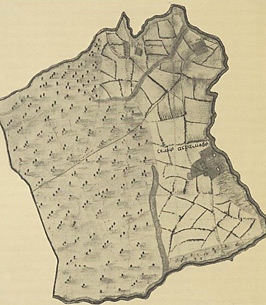ABRAMTSEVO IN THE 16th – FIRST HALF OF THE 19th CENTURY The first mentions of Abramtsevo date back to the 16th century. In the 1580s the place called "Obramkovo" along with the nearby village Mutovki was the property of the landowner Volynsky. The following period of the first Romanovs` reign left no documents relating to the history of this place.
At the beginning of the 18th century Abramkovo, as it was called then, was acquired by Fyodor Golovin – the representative of an old noble family that became famous in time of Peter the Great. Having served 20 years in the Navy, Golovin retired in 1727 and settled in Abramkovo. He lived there more than half of a century rarely leaving this place, occupied entirely with the planning of the estate that even today keeps features of his management. The one-storey Manor House was located on the high bank of the River Vorya. To the west the house faced a cour d'honneur surrounded by utility buildings. Two ponds were located behind the courtyard. A fruit garden occupied the northern part of the estate while a regular park descending to the river was laid out to the east. The road from the estate led to the Pokrovsky (Patronage of the Mother of God) Monastery in the nearby Khotkovo where it forked, and one of the roads ran to the Holy Trinity-St. Sergius Lavra (monastery) and the second one stretched to Moscow. Abramkovo, the owner's residence, and two adjoining villages Bykovo and Mutovki accounted for only one and half a dozen of peasant houses. The estate did not bring much income. But this place was attractive for its picturesque outskirts, hunts in game-filled forests, fish caught in the river and ponds, woods rich in berries and mushrooms. Fyodor Golovin owned the estate till 1783 and then during a short period of time Abramkovo witnessed several owners who did not stay there long. In 1797 Abramkovo was purchased by Larion Molchanov. He and his family possessed the estate till 1840. At that period the Manor House got a mezzanine, the regular park became terraced and a new pond appeared next to the river. All these changes were reserved till nowadays. The status of the estate is clarified by the economic description of the Dmitrovsky district in the Moscow region dated back to the year 1800: "On the right bank of the river Vorya there is a wooden one-storey manor house and the fruit garden is next to it. The villages Bykova and Mutovka are also on the right bank of the river which in hot summer days is 3 sazhens wide, 1 arshin deep (1 sazhen is equivalent to 3 arshins or approximately 2 meters or 7 feet) and keeps the fish: pikes, perches, roaches. The river drives a watermill that functions all year round for the needs of peasant and nearby estates. The water is drinkable both for people and cattle. The forests contain much timber: pine and spruce; firewood: alder, maple, birch, hazel, and oak. In the forests there are animals: wolfs, hares, foxes, squirrels; birds: black grouses, hazel grouses, partridges and others. The silt soil with sand is appropriate for rye, barley, oats, buckwheat, flax, hemp, spring wheat as well as haymaking. Peasants work in fields and trade in firewood in Moscow. Women spin flax, fimble, wool and weave linen. Income is average". In 1841 the daughter of Larion Molchanov sold the estate to Vasily Nevedomsky, but just in a few years in 1843 the latter sold it to Sergey Aksakov. |

